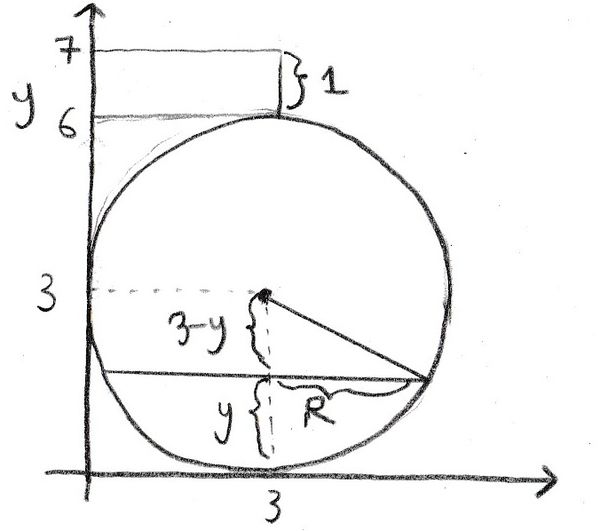Science:Math Exam Resources/Courses/MATH101/April 2014/Question 04/Solution 1
Before beginning, note that all of the units are compatible with each other (i.e. metres go with cubic metres) and so we can just use numbers. However, in general, make sure you convert to the correct units before solving the problem.
First, if we describe the given situation on the graph, we get
.
The formula for work is
with a small mass, the distance from the mass to where we want the water to go, and , the acceleration to move the mass.
Note that the mass of water and the distance from the water surface to the top of the tank are changed, as we pump the water. Thus, let’s introduce a variable which represents the depth of the water as measured from the bottom of the tank. (See the above picture). The goal then is to come up with an integral involving this variable (i.e. we want acceleration, distance out of the tank, and mass to be written in terms of ).
First, since the only force on the water we have to overcome is from gravity, the acceleration is constant and given by Earth's gravitational field, .
Next, since we're dealing with a fluid, it is often easier to use the density instead of mass directly, i.e. we can relate to the volume it takes up with the fluid density , via,
At a fixed depth, , it will be the same amount of work to remove a single drop as it will the whole disk of water at this depth. Denote the radius of the circle at depth by as in the picture. Then, satisfies
Therefore, the amount of volume we need to remove at depth is the small cylinder made from the disk of radius with a small amount of depth, ,
Finally, to setup the work, we need the height it takes to get the water out of the tank as a function of . This last step is important and often the most overlooked since at first glance it may seem like this height is the same as itself since they both measure distance. However, remember that is the depth measured from the bottom of the tank but we need to get the water out of the top of the tank. From the picture we see that the distance from the top of the tank to the bottom of the tank is 7. As the depth increases the distance to the top of the tank decreases as
Plugging everything together and using from the problem that ,
For the work required to pump all of the water in the tank, the range for is from 0 to 3, which implies



















![{\displaystyle {\begin{aligned}W&=\int _{0}^{3}(9.8)(7-y)\cdot 1000\pi (6y-y^{2})dy=9800\pi \int (7-y)(6y-y^{2})dy\\&=9800\pi \int _{0}^{3}y^{3}-13y^{2}+42ydy=9800\pi \left[{\frac {y^{4}}{4}}-13{\frac {y^{3}}{3}}+21y^{2}\right]_{y=0}^{y=3}\\&=9800\pi \left({\frac {3^{4}}{4}}-13{\frac {3^{3}}{3}}+21\cdot 3^{2}\right).\\&=904050\pi \end{aligned}}}](https://wiki.ubc.ca/api/rest_v1/media/math/render/svg/45d9ab2dc46d44feb5c5edd1cc7666ffae9644f0)